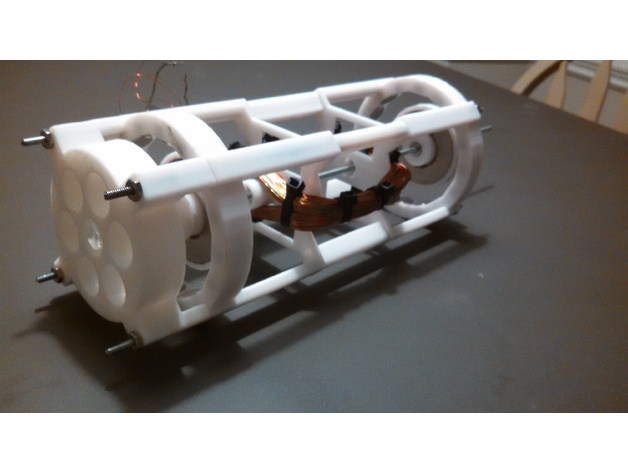
Magnetically Levitated Bedini/Cole Window Pulse Motor
thingiverse
Pulse motors produce little to no heat on the coils when properly wired, making plastics like PLA or ABS suitable materials for construction. John Bedini and Ron Cole developed a solid-state circuit paired with an induction coil configuration along the motor shaft's center to create the Bedini/Cole Window motor, a highly efficient pulse motor with adequate torque for practical applications. This technology has been extensively experimented upon by John Bedini over several decades, building upon the work of predecessors like Tesla. I consider him a genius in electronic circuits, holding multiple patents related to this field. A simple browser search for "Bedini" yields extensive information on his work. He collaborated with moderators at the Energy Science Forum (http://www.energyscienceforum.com/forum.php), an excellent resource for learning about radiant energy. This particular motor/energizer is a basic tool designed to teach concepts related to radiant energy, offering numerous opportunities for experimentation. Disclaimer: This simple device carries inherent risks. Catastrophic failure of parts moving at high speeds can lead to property damage, injury, or even death. Additionally, there's the risk of electrical shock and potential harm from strong neodymium magnets. Users should exercise caution and build at their own risk. Parts List: 32 .5" X .25" disc magnets sourced from (http://www.magnet4less.com) for outer magnetic levitation ring 2 ring magnets: 2" outer X 1" inner X .25" depth 6 bar magnets: 2" X .5" X 1/8" Optional for magnetic shaping experiment with rotor: 6 additional 2" X .5" X 1/8" for inner slots on the rotor 4-12" lengths of 6-32 threaded rod and 8 nuts to assemble the device 1/4" smooth rod for the center shaft, sourced from VXB Bearings.com A piece of glass or metal for the pointed end of the shaft or needle to ride against Loctite super glue is used to secure parts Printed parts were created using a Printrbot Play with a maximum printing area of 4" X 4" X 5". They are printed in Printrbot Snow White PLA, using .2 mm layers, 1.2 mm walls, and .8mm top and bottom layers. Infill is set to 20% except for ring magnet holders, which have 50-100% infill due to their 1/8" set screw holes. The wire and pulse circuit configuration are left up to the user, with various options available. A suitable starting point could be a circuit like this: http://www.teslagenx.com/kits/tx-sg4tub.html?category=kits|pcb Please exercise caution and enjoy experimenting! Direct questions and comments can be posted here: http://www.energyscienceforum.com/showthread.php?t=3380&page=7&p=26245#post26245. Additional information is available on this YouTube video: https://www.youtube.com/watch?v=p0Tj8U7_qMI. The rotor design has been revised to conceal the magnets from external exposure.
With this file you will be able to print Magnetically Levitated Bedini/Cole Window Pulse Motor with your 3D printer. Click on the button and save the file on your computer to work, edit or customize your design. You can also find more 3D designs for printers on Magnetically Levitated Bedini/Cole Window Pulse Motor.
